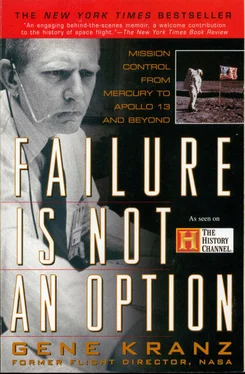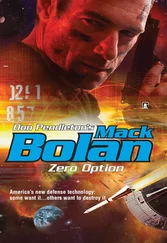The tracking network voice system used a massive manual switchboard up at Goddard; its operator plugged cables into a bewildering assortment of jacks as he performed a frenetic ballet. He carried a thick bundle of cables wrapped around his arm, darting from one part of the big switchboard to another, making connections manually so we could talk to tracking sites and working around bad circuits to provide alternative connections. This remarkable guy, known as “Goddard voice,” was another guardian angel.
Since we never knew whether every link had heard the voice exchanges, as a cross-check I transcribed every major communication into a Teletype message. We didn’t have computers in Mercury Control. So the radar information from the launch, orbit, and reentry was transmitted by tracking sites around the world to the computers at Goddard for processing, and then sent down to drive the plot boards in Mercury Control. Advanced as they were at the time, and filling whole large rooms, those computers had a speed and processing capacity easily exceeded by desktop PCs today. So our margins for error were made even thinner by the limitations of these resources.
While waiting for Kraft’s full team to arrive from Langley I explored everything from the launch pad to Hangar S, where they checked out the spacecraft prior to launch. I was welcomed everywhere by engineers and technicians who were as new to their jobs as I was. All of them were eager to discuss their work, trade ideas, and figure out how each of us fit into the total picture. I felt that I was not alone, that virtually everyone was writing their game plan as they went along. I felt an undercurrent of organization that was emerging from a leadership structure still solidifying.
By the time Kraft and the rest arrived at the Cape, I was no longer feeling like a rookie. I had spent every available moment in Mercury Control, prowling through the room and listening to the check-out, observing how the technicians handled communications with “Goddard voice,” the tracking stations, and the blockhouse.
Project Mercury was literally having trouble getting off the ground. In August of 1960, after the first Mercury-Atlas exploded in flight, the major journal in the aerospace business, Missiles and Rockets, stated: “NASA’s Mercury manned satellite program appears to be plummeting the United States toward a new humiliating disaster in the East-West space race. The program is more than one year behind the original schedule and is expected to slip to two. It no longer offers any realistic hope of beating Russia in launching the first man into orbit, much less to serve as an early stepping-stone for reaching the Moon.”
The testing of the Mercury capsule escape system was carried out at the Wallops Island Station just below the Maryland-Virginia border. This was a Langley test facility for all sorts of “sounding,” or high-altitude research rockets. The tests of the escape system were about 50 percent successful. While we were getting ready at the Cape, one of the Mercury tests at Wallops failed spectacularly on November 8. Sixteen seconds after launch the escape and jettison rockets fired prematurely, thus leaving the capsule attached to the booster rocket, which reached a ten-mile apex and then came screaming back to Earth, destroying the capsule at impact.
The Mercury program used two booster rockets—the Redstone and the Atlas. Both were derivatives of military systems but with vastly different capabilities. The Redstone was an Army battlefield rocket. It would be used to start the capsule systems qualification test flight and, if that was successful, for two ballistic manned missions. The ballistic missions were to be about twenty minutes in duration, reaching a maximum altitude of about 130 miles and providing a short weightless period before reentry. The Atlas was an Air Force intercontinental missile and was to be used for both ballistic and orbital Mercury missions. The first three missions were ballistic, to continue the booster and capsule qualification, test the tracking network, and provide experience for the MCC team. The orbital testing would continue the qualification testing using the mechanical man and a chimpanzee before the manned orbital flights.
When Mercury-Atlas 1 exploded in flight, we fell about one year behind in the schedule, so a lot was riding on the first Mercury-Redstone flight, MR-1. Kraft’s team arrived on November 13 for the MR-1 launch, now only eight days away. Once again my guardian angel, Johnson, arrived to save my bacon. He took a place to the right of the console and punched up the buttons of the intercom during our simulation dress rehearsal.
Immediately, a half dozen different conversations flooded through my headset. It reminded me of the cool, almost casual but terse and clear voice chatter that came up on the tactical frequency when things heated up during the time I was in Korea directing air strikes on ground targets. As I listened, I picked up the voices of the test conductors. Johnson broke out some thick documents and advised Kraft of the page and sequence of the countdown. It was fortunate that this was just a test. It gave Johnson a chance to brief me on the countdown process, get to know the people talking on the loops and Mercury Control’s role in the test.
At intervals, Johnson encouraged me as the MCC procedures controller to make suggestions to Kraft or one of the other controllers. Throughout the test, he glanced around the room and made mental notes about what people at the various console positions should be doing or doing in a different way. Periodically, I would print out a message and call the ground communications controller. Eshelman would rush into the room to pick up the message, put it on the Teletype line, and then rush back with a confirming copy of the transmitted text. After several hours, I picked up the routine of the count and felt comfortable, as long as all was going well.
This first mission in which I would play a role was a ballistic test of a Redstone booster rocket and a Mercury capsule. The Redstone’s engine was scheduled to burn for two and one half minutes. After the booster engine cut off, the escape tower separated from the capsule by firing the tower ring attachment bolts and igniting the tower escape rocket. Then after the booster thrust had decayed, explosive bolts would fire, followed by the firing of three small posigrade solid rockets, to separate the capsule from the booster. (“Posigrade” is the term used for adding velocity in the direction of flight, in this instance the small rockets used to separate the Mercury capsule from the booster. Retrograde rockets fire opposite to the direction of flight.) The Redstone boosted the spacecraft to an altitude of 130 miles before it started to arc downward.
At 20,000 feet, the capsule’s drogue parachutes would deploy, stabilize its motion, and slow it down sufficiently to allow the main parachutes to deploy safely. Then the landing sequence would begin. The entire mission was planned to last only sixteen minutes. After the countdown simulation test we began training for the brief actual flight of the Redstone. For three days we rehearsed, calling out events and issuing backup commands to the automatic sequences.
During the simulation run-through our instructors sat watching us from their vantage point at the top row of the consoles and played magnetic tapes into the telemetry and radar systems, which in turn drove the controller’s meters and plot board displays. If all else failed, we would be handed a written question, like a pop quiz in school. You had to stand up in front of the entire Mission Control Center team and say, “Flight! A new problem has shown up and this is what I am going to do about it.” You took it seriously. God help you if you couldn’t come up with an answer—instantly.
Читать дальше












